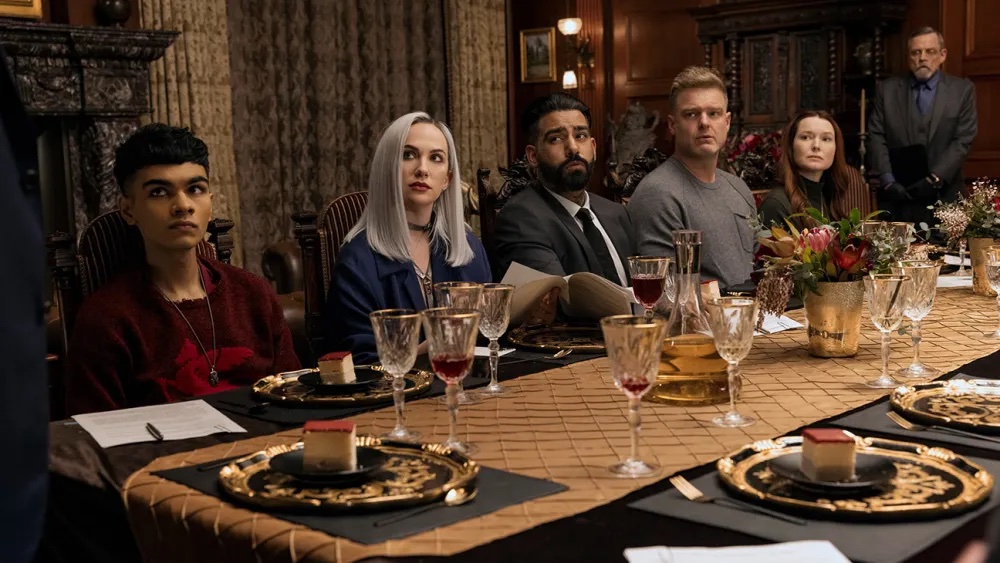
c/o Eike Schroter at Netflix
What would you do if one by one, all of your children began dying in horrific and grotesque ways? Such is the premise of Mike Flanagan’s “The Fall of the House of Usher,” based on the short story of the same name by Edgar Allan Poe. The latest installment in Flanagan’s growing repertoire of critically acclaimed horror media, which was released on Netflix on Thursday, Oct. 12, “The Fall of the House of Usher” lives up to expectations with its fast pace, vibrant characters, and beautiful cinematography.
As always, “The Fall of the House of Usher” is filled with a cast of recurring actors featured in most of Flanagan’s other works, including “The Haunting of Bly Manor” (2020), “The Haunting of Hill House” (2018), “Gerald’s Game” (2017), and “Midnight Mass” (2021). There are a few newcomers, however, both acting veterans and newbies alike. Sauriyan Sapkota only has two acting credits to his name, both of which are works by Flanagan (“The Midnight Club” and “The Fall of the House of Usher”). Ruth Codd is in a similar position, with only three credits to her name, two of which are the same Flanagan films Sapkota acted in. Then there’s Willa Fitzgerald—no stranger to the horror genre and best known for her lead role in the “Scream” (2015) revival TV series. Acting veteran Mary McDonnell makes her Flanagan debut as the alluring Madeline Usher, twin sister to Roderick Usher (Bruce Greenwood). But most excitingly there is the iconic Mark Hamill, as Arthur Pym, a role that puts him in an arduous position acting-wise that audiences have never really seen him in before. Hamill is no stranger to branching into new genres, and he takes on this role with a certain dedication that truly immerses audiences into his character. He is not the lovable Jedi Luke Skywalker here; he is wholly and completely Arthur Pym, the Usher family’s ruthless attorney.
The TV series maintains the same tone as the source material, retaining the sense of impending doom present throughout Poe’s piece, but changing many details in favor of a more modern adaptation. First and foremost, the narrator, Detective Auggie (Carl Lumbly and Malcolm Goodwin), and the family patriarch, Roderick Usher (Bruce Greenwood and Zach Gilford) have a uniquely close relationship in the TV series and have grown to hate each other over the last couple of decades. However, in the short story, it’s implied that the narrator hasn’t seen the patriarchal Usher in a long time. The timeline is also altered, with Roderick telling the story in a single day to the detective in the series, while Poe’s story unfolds over the course of several days. The house is described similarly in both pieces of work: still standing and yet in a state of decaying disarray, it is representative of Roderick’s relationships and the irreparable damage that he has caused, as well as his declining mental health. Most surprisingly, however, is the absence of his children in the source material, who play such an important role in the show that the short story feels almost hollow in comparison. This is not the first time Flanagan has altered source material to appeal to a more familial motif, though. In “The Haunting of Hill House,” he famously changed the story so that the Crains would all be siblings instead of strangers meeting for the first time.
The tone of “The Fall of the House of Usher” is decidedly different from the rest of Flanagan’s works. While they have always been particularly dark, it is very clear early on in the show that “The Fall of the House of Usher” will be more daring. Someone gets permanently scarred by corrosive acid rain, a raging chimp mauls off another person’s face, and at one point, teeth are pulled out with pliers and thrown into an Altoids tin. Flanagan has always been willing to venture outside the ordinary when it comes to horror, but “The Fall of the House of Usher” takes his no-holds-barred approach to the extreme.
While different in many ways, “The Fall of the House of Usher” still has Flanagan’s signature flair. There are beautifully ominous shots that are perfectly staged, fully placing the watcher in the universe Flanagan builds with the Usher family. There is a heavy emphasis on the concept of family and breaking generational curses (literally) of greed and detached parenting.
Overall, “The Fall of the House of Usher” is definitely among Flanagan’s best pieces of work. While it differs pretty drastically from the source material in its overall themes and characters, it still manages to maintain the same tone and sense of dread that Edgar Allan Poe is most famously known for.
Celeste McKenzie can be reached at cmckenzie01@wesleyan.edu.